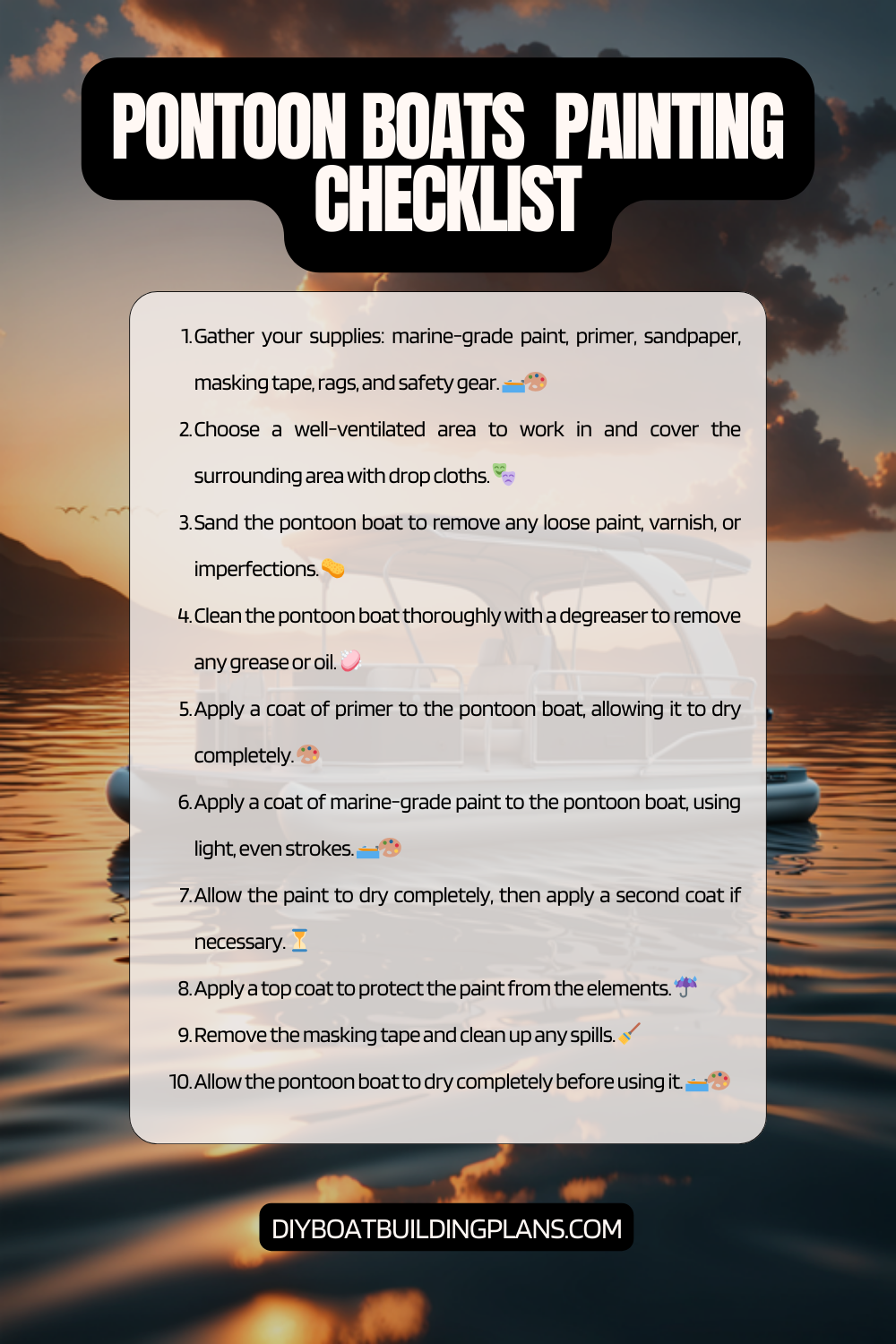Overview of Pontoon Boat Painting Tips
Pontoon boats are a popular choice for leisurely cruises on the water, but over time, their paint can become faded, chipped, or worn. This is where pontoon boat painting comes in. Painting your pontoon boat not only enhances its appearance but also protects it from the harsh elements of the water. Whether you want to give your boat a fresh new look or simply restore its original beauty, painting is a great option.
However, before diving into the painting process, it’s crucial to understand the importance of proper preparation and technique. Rushing through these steps can result in a subpar paint job that won’t last long. Taking the time to prepare your boat and using the right techniques will ensure a professional-looking finish that will withstand the test of time.
Key Takeaways
- Choosing the right paint is crucial for a successful pontoon boat painting project.
- Proper preparation, including sanding and priming, is essential for a smooth and long-lasting finish.
- Masking and taping can help achieve clean lines and a professional-looking result.
- Caring for your newly painted pontoon boat involves regular maintenance and cleaning.
- Avoid common mistakes such as rushing the process or using the wrong type of paint.

Choosing the Right Paint for Your Pontoon Boat
When it comes to choosing paint for your pontoon boat, there are several factors to consider. First and foremost, you’ll want to select a paint that is specifically designed for marine use. Marine paints are formulated to withstand the constant exposure to water, UV rays, and other environmental factors that can cause regular paint to deteriorate quickly.
There are different types of marine paints available, including one-part and two-part paints. One-part paints are easier to apply and generally more affordable, but they may not offer the same level of durability as two-part paints. Two-part paints require mixing a base and an activator, resulting in a stronger and more long-lasting finish.
Additionally, consider the color and finish of the paint. While personal preference plays a role in this decision, it’s important to choose a color that complements your boat’s overall aesthetic and stands out on the water. As for the finish, you can opt for a glossy or matte look depending on your desired style.
Preparing Your Pontoon Boat for Painting
Before you can start painting your pontoon boat, proper preparation is key. This involves thoroughly cleaning the boat to remove any dirt, grime, or residue that could interfere with the paint’s adhesion. Use a mild detergent and water to wash the entire surface of the boat, paying extra attention to areas that are prone to buildup, such as the pontoons and the transom.
Next, if your boat has any existing paint or decals, they will need to be removed. Use a paint scraper or a heat gun to carefully strip away the old paint. Be cautious not to damage the underlying surface in the process. If there are any cracks or holes in the boat, now is the time to fill them in with an appropriate marine filler. Smooth out the filler with sandpaper once it has dried.
Sanding Techniques for a Smooth Finish
| Sanding Technique | Description | Advantages | Disadvantages |
| Hand Sanding | Sanding by hand using sandpaper or sanding blocks. | Controlled sanding, good for small areas, inexpensive. | Time-consuming, can cause uneven sanding, can be tiring. |
| Power Sanding | Sanding using a power tool such as an orbital sander or belt sander. | Efficient, saves time, good for large areas. | Can be expensive, can cause damage if not used properly, can create dust. |
| Wet Sanding | Sanding using water to lubricate the surface and reduce dust. | Produces a smooth finish, reduces dust, good for finishing coats. | Can be messy, requires more time and effort, can cause rust if not dried properly. |
| Buffing | Using a buffing wheel or pad to polish the surface. | Produces a high-gloss finish, good for final finishing, can remove scratches. | Requires special equipment, can be expensive, can cause damage if not used properly. |
Sanding is a crucial step in achieving a smooth and even paint finish on your pontoon boat. It helps remove any imperfections, roughness, or old paint remnants that could affect the final result. Start by using coarse-grit sandpaper to tackle any stubborn areas or rough surfaces. As you progress, switch to finer-grit sandpaper for a smoother finish.
Different types of sandpaper can be used depending on the task at hand. For initial sanding and removing old paint, coarse-grit sandpaper with a lower number (around 80-120) is recommended. As you move towards achieving a smooth finish, gradually switch to finer-grit sandpaper with higher numbers (around 220-400).
When sanding, it’s important to maintain a consistent pressure and motion. Sand in long, even strokes, following the grain of the boat’s surface. Avoid applying too much pressure as it can damage the underlying material. Take breaks periodically to check your progress and ensure you’re achieving a uniform surface.
Masking and Taping for Clean Lines
To achieve clean lines and prevent overspray, proper masking and taping techniques are essential. Before you start painting, identify the areas that you don’t want to paint, such as the windows, trim, or any other parts that should remain unpainted. Use painter’s tape to carefully mask off these areas, ensuring a tight seal between the tape and the boat’s surface.
When applying the tape, take your time to ensure it is straight and aligned with the edges you want to protect. Press down firmly on the tape to create a secure bond. For curved or irregular surfaces, use small pieces of tape to achieve a smooth transition. This will help prevent paint from seeping underneath the tape and creating messy edges.
Additionally, consider using plastic sheeting or drop cloths to cover larger areas that are adjacent to the parts you’re painting. This will protect them from accidental overspray and make cleanup easier. Taking the time to properly mask and tape off areas will result in clean lines and a professional-looking finish.
Priming Your Pontoon Boat for Painting
Priming your pontoon boat is a crucial step that should not be overlooked. Primer acts as a bonding agent between the boat’s surface and the paint, ensuring better adhesion and durability. It also helps seal any imperfections or porous areas, creating a smoother base for the paint.
There are different types of primers available, including epoxy-based primers and self-etching primers. Epoxy-based primers are highly durable and provide excellent adhesion, making them suitable for boats that will be exposed to harsh conditions. Self-etching primers are designed specifically for metal surfaces and create a chemical bond with the metal, preventing corrosion.
When applying primer, follow the manufacturer’s instructions regarding mixing ratios and application techniques. Use a high-quality brush or roller to ensure even coverage. Apply thin coats of primer, allowing each coat to dry completely before applying the next. This will help prevent drips, runs, and uneven surfaces.
Applying Paint to Your Pontoon Boat
Now comes the exciting part – applying paint to your pontoon boat. Before you start, make sure you have chosen the right type of paint for your boat and have all the necessary tools and equipment on hand. Depending on the type of paint you’re using, different application techniques may be required.
For one-part paints, a brush or roller is typically sufficient for application. Start by cutting in around the edges and corners with a brush, then use a roller to cover larger areas. Apply thin coats of paint, allowing each coat to dry before applying the next. This will help prevent drips, runs, and uneven surfaces.
Two-part paints often require spraying equipment for application. If you’re not familiar with spray painting techniques, it may be worth seeking professional assistance or practicing on a small area before tackling the entire boat. Follow the manufacturer’s instructions regarding mixing ratios, spray gun settings, and application techniques for optimal results.
Tips for Achieving a Professional-Looking Finish
To achieve a professional-looking finish on your pontoon boat, attention to detail is crucial. Here are some tips to help you avoid common mistakes and achieve outstanding results:
1. Take your time: Rushing through the painting process can lead to sloppy workmanship and unsatisfactory results. Set aside ample time for each step and allow sufficient drying time between coats.
2. Maintain consistent strokes: Whether you’re using a brush, roller, or spray gun, maintain consistent strokes or patterns throughout the application process. This will help create an even finish and minimize visible brush or roller marks.
3. Avoid overloading the brush or roller: Excess paint on your brush or roller can lead to drips and uneven coverage. Load your brush or roller with an appropriate amount of paint and remove any excess before applying it to the boat.
4. Work in small sections: Instead of trying to paint the entire boat at once, work in small sections. This will allow you to maintain control over the paint application and ensure a consistent finish.
5. Check for imperfections: Regularly inspect your work for any imperfections, such as drips, runs, or uneven coverage. Address these issues promptly by sanding or touching up the affected areas.
Caring for Your Newly Painted Pontoon Boat
Once you’ve completed the painting process and achieved a beautiful finish on your pontoon boat, it’s important to take proper care of it to ensure its longevity. Here are some tips for maintaining your newly painted boat:
1. Regular cleaning: Wash your boat regularly with mild detergent and water to remove dirt, salt, and other contaminants that can degrade the paint over time. Avoid using abrasive cleaners or brushes that could scratch the surface.
2. Waxing and polishing: Apply a high-quality marine wax or polish to protect the paint and enhance its shine. This will create a barrier against UV rays, saltwater, and other environmental factors that can cause fading or damage.
3. Avoid harsh chemicals: When cleaning your boat or removing stains, avoid using harsh chemicals that could strip away the paint or cause discoloration. Stick to gentle cleaners that are safe for marine use.
4. Prevent damage: Take precautions to prevent damage to the paint, such as using fenders when docking, avoiding contact with sharp objects or abrasive surfaces, and storing your boat in a covered area when not in use.
Download over 500 Boat Plans. Click on the link below.
-->Click Here<--
Common Mistakes to Avoid When Painting Your Pontoon Boat
While painting your pontoon boat can be a rewarding project, there are some common mistakes that you should be aware of and avoid:
1. Insufficient preparation: Skipping or rushing through the preparation process can result in poor adhesion, peeling, or bubbling of the paint. Take the time to properly clean, sand, and prime your boat before painting.
2. Inadequate ventilation: Painting in a poorly ventilated area can lead to fumes and overspray settling on the wet paint, causing imperfections. Ensure proper ventilation or consider painting outdoors if weather conditions permit.
3. Applying too thick coats: Applying thick coats of paint may seem like a time-saving technique, but it can lead to drips, runs, and uneven surfaces. Thin coats allow for better control and smoother finishes.
4. Ignoring weather conditions: Painting in extreme temperatures or high humidity can affect the drying and curing process of the paint. Follow the manufacturer’s recommendations regarding temperature and humidity ranges for optimal results.
5. Neglecting touch-ups: Over time, your boat may encounter minor scratches or chips in the paint. Promptly addressing these issues with touch-up paint will help maintain the overall appearance and protect against further damage.
Pontoon Boat Painting Checklist

Conclusion – Pontoon Boat Painting Tips
Painting your pontoon boat can be a rewarding project that not only enhances its appearance but also protects it from the elements. By following the proper preparation techniques, choosing the right paint, and applying it with care, you can achieve a professional-looking finish that will last for years to come.
Remember to take your time throughout the process, paying attention to detail and avoiding common mistakes. Properly caring for your newly painted boat will help maintain its beauty and protect your investment. With these tips and techniques in mind, you can confidently take on the task of painting your pontoon boat and enjoy the fruits of your labor on your next water adventure.
FAQs – Pontoon Boat Painting Tips
What is a pontoon boat?
A pontoon boat is a type of boat that has two or more pontoons, or cylindrical tubes, that provide buoyancy and stability on the water.
Why would I need to paint my pontoon boat?
Painting your pontoon boat can help protect it from the elements, prevent rust and corrosion, and improve its appearance.
What type of paint should I use on my pontoon boat?
It is recommended to use marine-grade paint specifically designed for use on boats. This type of paint is formulated to withstand exposure to water, sunlight, and other harsh conditions.
What preparation is required before painting my pontoon boat?
Before painting your pontoon boat, you should thoroughly clean and sand the surface to remove any dirt, grime, or old paint. You may also need to apply a primer to ensure proper adhesion of the new paint.
Can I paint my pontoon boat myself?
Yes, you can paint your pontoon boat yourself if you have the necessary tools and experience. However, it is recommended to hire a professional if you are unsure of the process or do not have the proper equipment.
How often should I repaint my pontoon boat?
The frequency of repainting your pontoon boat will depend on several factors, including the type of paint used, the amount of use and exposure to the elements, and the quality of the previous paint job. Generally, it is recommended to repaint your pontoon boat every 3-5 years.



